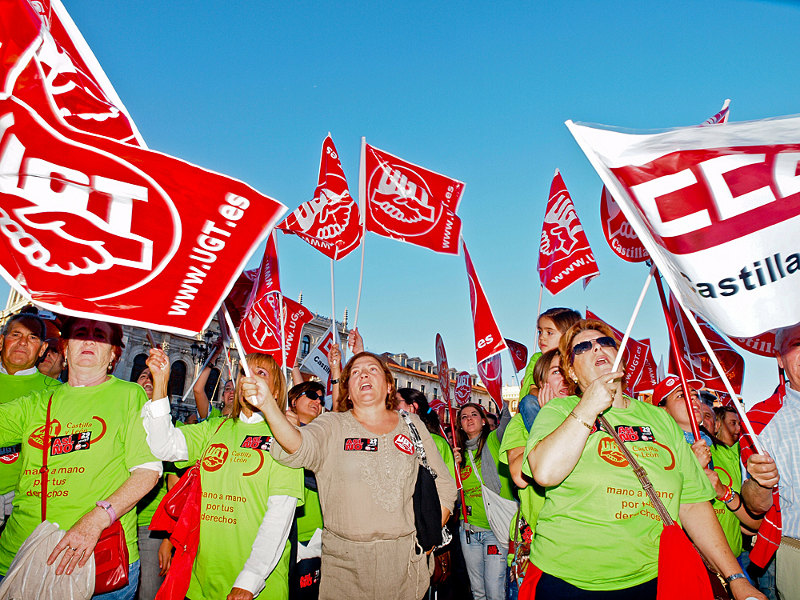In Spain the workers responded massively to the unions’ call of for a general strike on September 29. In addition to the two main trade union confederations, the UGT and CCOO, the strike was supported by many smaller unions: CGT, SOC / SAT (Andalusia), IGC (Galicia), CSI (Asturias), STEs (teachers) and others. Many members of Left parties, especially the Communist Parties and United Left participated actively in many areas of Spain. [The following report has been compiled from reports sent from Spain]
The most important element was a tremendous sense of unity among the workers. Andre Bódalo, head of the Andalusian union of workers (formerly SOC) in Jaén told members of the IMT:
"There has been a great deal of unity between the unions, from the base up. (...) I would highlight the collaboration between workers and capital Jaén and those who come from the villages, the camaraderie and fraternisation between members of all unions, and the feeling of fellowship that has been created on the picket line."
This was the mood of the workers despite the fact that the trade union leaders had dragged their feet in calling the strike. Despite the attempts of the union leaders to reach a deal, the Socialist government, in agreement with the main right-wing groups, accelerated parliamentary procedures to approve the labor reform on September 9, presenting it as a fait accompli and head off the mobilisation.
The media anti-union campaign that has been going on for months reached a crescendo. Unlike 2002 this strike took place under a PSOE government. Despite all these difficulties, the response to the strike surpassed all the expectations of the union leaders. In all the main industries, engineering and construction, the strike was widely followed. The only exception was Euskadi (the Basque Country) where the nationalist unions did not call for a strike.
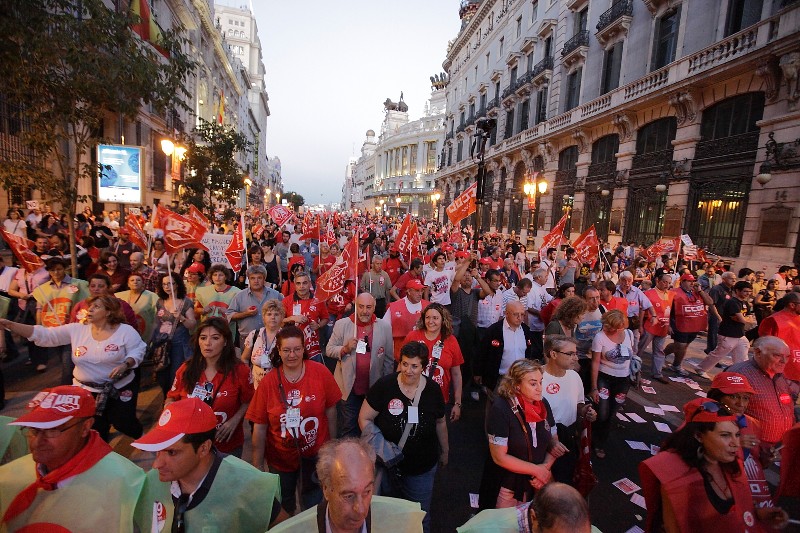 Madrid. Photo: UGT Madrid The strike stopped all distribution centres and large markets in the major cities, the fleets of inshore and offshore fishing were tied up in the main ports, the collection of refuse in large cities was halted, and the street cleaners in Madrid also joined the strike. The day labourers in many villages of Andalusia, especially those under the influence of the SAT in the mountains of Cadiz, and the southern mountains of Seville, Jaen (Mengíbar, Pegalajar, Jódar) etc., answered the strike call massively.
Madrid. Photo: UGT Madrid The strike stopped all distribution centres and large markets in the major cities, the fleets of inshore and offshore fishing were tied up in the main ports, the collection of refuse in large cities was halted, and the street cleaners in Madrid also joined the strike. The day labourers in many villages of Andalusia, especially those under the influence of the SAT in the mountains of Cadiz, and the southern mountains of Seville, Jaen (Mengíbar, Pegalajar, Jódar) etc., answered the strike call massively.
TV programmes were suspended in a large part of regional television in Andalusia and Madrid, and partly in other stations. According to the state-owned electricity network there was a drop in electricity consumption of between 19% and 21%. These data resemble those on holidays and Sundays. However, the next day, they said that the average fall "throughout the day was only 14%.”
According to the state radio, "Asturias was paralysed". In Catalonia, Vigo, Gibraltar, the industrial areas of Cantabria, Las Palmas de Gran Canaria, Murcia, Zaragoza and its industrial belt, the general strike was even more solid than in 2002. In some cities, there were real battles against the owners of large commercial establishments. Outside the big chain store El Corte Inglés large numbers of pickets gathered (more than in 2002). In Jaén and Murcia they were forced to close for a time, and in Zaragoza they were closed completely when 500 pickets turned up, shouting “Long live the struggle of the working class.”
Mass demonstrations
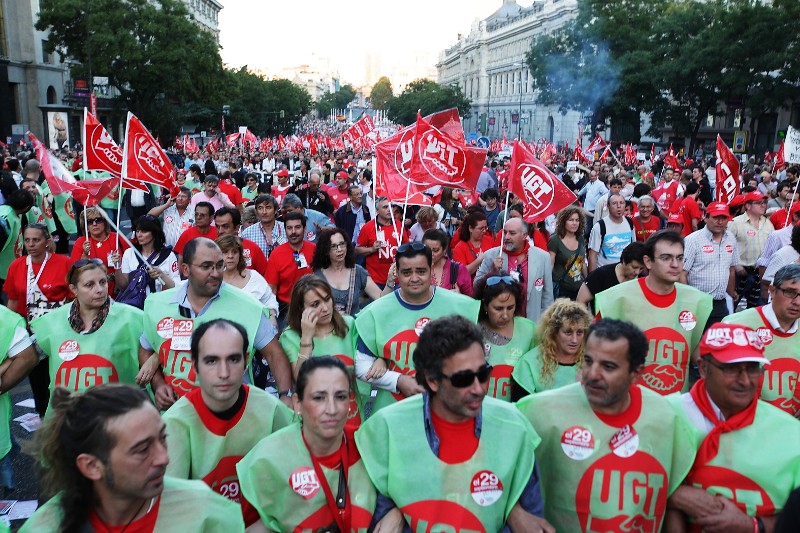 Madrid. Photo: UGT Madrid The general strike was accompanied by mass demonstrations. There were a total of over 100 demonstrations across the country. The predominant mood was one of confidence and strength.
Madrid. Photo: UGT Madrid The general strike was accompanied by mass demonstrations. There were a total of over 100 demonstrations across the country. The predominant mood was one of confidence and strength.
According to figures of the trade unions UGT and CCOO, 500,000 people demonstrated in Madrid and 400,000 in Barcelona. In Andalusia the largest demonstration was in Seville with 50,000 participants, followed by Huelva and Cordoba with 20,000 each, and Malaga with 18,000. In Jaén, there were over 7,000 people, almost double the number in 2002.
In Aragon, Zaragoza there were 100,000 people in the demonstration – again, more than in 2002. There were also significant movements in Huesca, Sabiñánigo, Barbastro, Monsoon, Caspe, Teruel, Alcaniz, Ejea and Taussig.
In Oviedo (Asturias) 100,000 people participated, along with 10,000 who responded to the call organised by the CSI. There were meetings and demonstrations in Castilla and León, notably in Valladolid, and 10,000 in Santander (Cantabria).
In Galicia there were 70,000 in the UGT-CCOO demonstration in Vigo and another 40,000 on the demo called by the nationalist IGC. On the Balearic the islands the figure was 20,000, while in the Canary Islands it reached 21,800. Particularly noteworthy were the 10,000 demonstrators in Gran Canaria and Tenerife's 7,500.
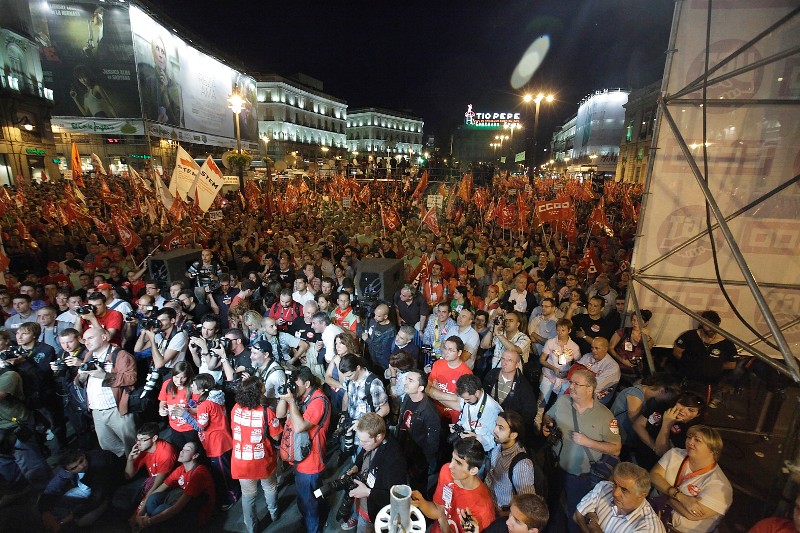 Madrid. Photo: UGT Madrid There were 20,000 protesters in demonstrations in Murcia, including 5,000 in Cartagena, and a total of 90,000 in Valencia, with 40,000 in Alicante and 20,000 in Castellón. There were 10,000 demonstrators in Pamplona, which paralysed the main industrial area of Landaben (where the factory of Volkswagen is). In Bilbao 8,000 demonstrated; and another 2,000 in Donostia (San Sebastian); and 2.500 in Vitoria. In Álava Sidenor, Arregui stopped, as well as small engineering factories and a minority in Mercedes and Michelin, despite the sabotage of the nationalist unions.
Madrid. Photo: UGT Madrid There were 20,000 protesters in demonstrations in Murcia, including 5,000 in Cartagena, and a total of 90,000 in Valencia, with 40,000 in Alicante and 20,000 in Castellón. There were 10,000 demonstrators in Pamplona, which paralysed the main industrial area of Landaben (where the factory of Volkswagen is). In Bilbao 8,000 demonstrated; and another 2,000 in Donostia (San Sebastian); and 2.500 in Vitoria. In Álava Sidenor, Arregui stopped, as well as small engineering factories and a minority in Mercedes and Michelin, despite the sabotage of the nationalist unions.
Repression
During the general strike there was an aggressive police presence that has not been seen in the last decade. A constant feature was the presence of plain clothes police at the picket lines. The most serious incident occurred in Getafe, in the factories of the big CASA aeronautical company. It is not entirely clear what happened, but it seems that the pickets discovered two plain clothes policemen and surrounded them. Subsequently, the police rescued them firing live ammunition into the air. Union representatives at a news conference showed seven spent shell casings collected at the scene.
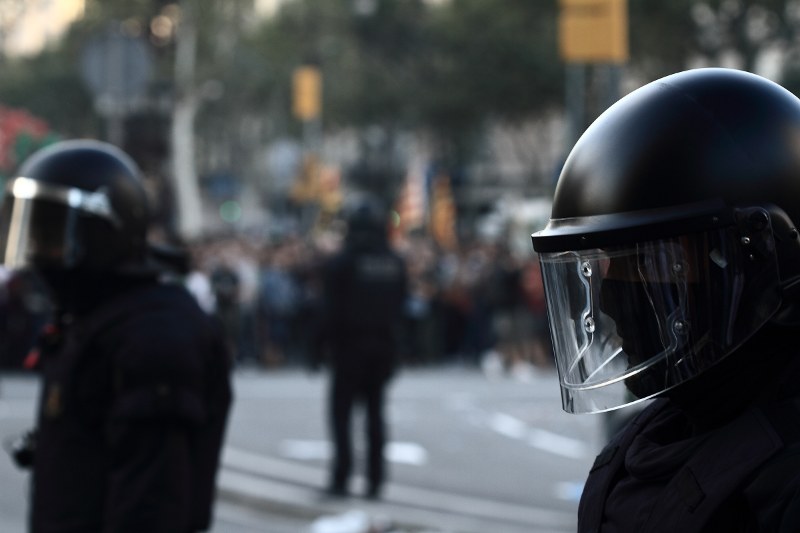 Photo: Ferran Moya A provocation organised in Barcelona is probably the cause that led to the early termination of the demonstration in Barcelona. In Seville the police entered the Rectorate of the University, hitting left and right, as proven by the videos carried on the website of the SAT (www.sindicatoandaluz.com). In Valencia, a protester had to be operated as a result of police beatings. In Madrid, there have been 60 detainees. At least 30 people were arrested in Catalonia, and dozens more in other parts of the country. 1500 people have had their personal data taken by the police in the protests.
Photo: Ferran Moya A provocation organised in Barcelona is probably the cause that led to the early termination of the demonstration in Barcelona. In Seville the police entered the Rectorate of the University, hitting left and right, as proven by the videos carried on the website of the SAT (www.sindicatoandaluz.com). In Valencia, a protester had to be operated as a result of police beatings. In Madrid, there have been 60 detainees. At least 30 people were arrested in Catalonia, and dozens more in other parts of the country. 1500 people have had their personal data taken by the police in the protests.
All these reports reveal that the Spanish working class, in line with its brothers and sisters across Europe, are not prepared to accept the draconian austerity measures being imposed on them. They know who as to blame for the crisis and they are not prepared to pay for it.

